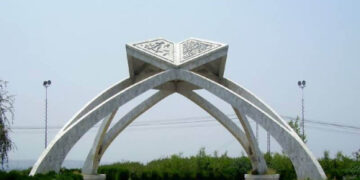 CHICAGO: It was a monumental project with modest beginnings: a small group of scholars and some index cards. The plan was to explore a long-dead language that would reveal an ancient world of chariots and concubines, royal decrees and diaries — and omens that came from the heavens and sheep livers.The year: 1921. The place: The University of Chicago. Assembling an Assyrian dictionary based on words recorded on clay or stone tablets unearthed from ruins in Iraq, Iran, Syria and Turkey, written in a language that hadn’t been uttered for more than 2,000 years. The scholars knew the project would take a long time. No one quite expected how very long.Decades passed. The team grew. Scholars arrived from Vienna, Paris, Copenhagen, Jerusalem, Berlin, Helsinki, Baghdad and London, joining others from the U.S. and Canada. One generation gave way to the next, one century faded into the next. Some signed on early in their careers; they were still toiling away at retirement. The work was slow, sometimes frustrating and decidedly low-tech: Typewriters. Mimeograph machines. And index cards. Eventually, nearly 2 million of them.And now, 90 years later, a finale. The Chicago Assyrian Dictionary is now officially complete — 21 volumes of Akkadian, a Semitic language (with several dialects, including Assyrian) that endured for 2,500 years. The project is more encyclopedia than glossary, offering a window into the ancient society of Mesopotamia, now modern-day Iraq, through every conceivable form of writing: love letters, recipes, tax records, medical prescriptions, astronomical observations, religious texts, contracts, epics, poems and more.Why is there a need for a dictionary of a language last written around A.D. 100 that only a small number of scholars worldwide know of? Gil Stein, director of the university’s Oriental Institute (the dictionary’s home), has a ready answer:”The Assyrian Dictionary gives us the key into the world’s first urban civilization,” he says. “Virtually everything that we take for granted … has its origins in Mesopotamia, whether it’s the origins of cities, of state societies, the invention of the wheel, the way we measure time, and most important the invention of writing.”If we ever want to understand our roots,” Stein adds, “we have to understand this first great civilization.”
CHICAGO: It was a monumental project with modest beginnings: a small group of scholars and some index cards. The plan was to explore a long-dead language that would reveal an ancient world of chariots and concubines, royal decrees and diaries — and omens that came from the heavens and sheep livers.The year: 1921. The place: The University of Chicago. Assembling an Assyrian dictionary based on words recorded on clay or stone tablets unearthed from ruins in Iraq, Iran, Syria and Turkey, written in a language that hadn’t been uttered for more than 2,000 years. The scholars knew the project would take a long time. No one quite expected how very long.Decades passed. The team grew. Scholars arrived from Vienna, Paris, Copenhagen, Jerusalem, Berlin, Helsinki, Baghdad and London, joining others from the U.S. and Canada. One generation gave way to the next, one century faded into the next. Some signed on early in their careers; they were still toiling away at retirement. The work was slow, sometimes frustrating and decidedly low-tech: Typewriters. Mimeograph machines. And index cards. Eventually, nearly 2 million of them.And now, 90 years later, a finale. The Chicago Assyrian Dictionary is now officially complete — 21 volumes of Akkadian, a Semitic language (with several dialects, including Assyrian) that endured for 2,500 years. The project is more encyclopedia than glossary, offering a window into the ancient society of Mesopotamia, now modern-day Iraq, through every conceivable form of writing: love letters, recipes, tax records, medical prescriptions, astronomical observations, religious texts, contracts, epics, poems and more.Why is there a need for a dictionary of a language last written around A.D. 100 that only a small number of scholars worldwide know of? Gil Stein, director of the university’s Oriental Institute (the dictionary’s home), has a ready answer:”The Assyrian Dictionary gives us the key into the world’s first urban civilization,” he says. “Virtually everything that we take for granted … has its origins in Mesopotamia, whether it’s the origins of cities, of state societies, the invention of the wheel, the way we measure time, and most important the invention of writing.”If we ever want to understand our roots,” Stein adds, “we have to understand this first great civilization.”
The translated cuneiform texts — originally written with wedged-shaped characters — reveal a culture where people expressed joy, anxiety and disappointment about the same events they do today: a child’s birth, bad harvests, money troubles, boastful leaders.”A lot of what you see is absolutely recognizable — people expressing fear and anger, expressing love, asking for love,” says Matthew Stolper, a University of Chicago professor who worked on the project on and off over three decades. “There are inscriptions from kings that tell you how great they are, and inscriptions from others who tell you those guys weren’t so great. … There’s also lot of ancient versions of `your check is in the mail.’ And there’s a common phrase in old Babylonian letters that literally means `don’t worry about a thing.'”There were omens, too — ways of divining the future by reading smoke patterns, the stars, the moon and sheep livers.”Like all people at all times, they wanted to try to find some way of controlling their world,” says Martha Roth, the dictionary’s editor-in-charge and dean of humanities. “It’s very difficult to draw the line between actually believing and being superstitious.”Robert Biggs, professor emeritus at the university, devoted nearly a half century to the dictionary, sometimes uncovering tablets on digs in the Iraq desert, sometimes poring over texts in museums in London and Baghdad. His specialty is Babylonian medicine. For almost an entire year, he studied thousands of references to sheep livers.
For example: If a sheep’s gallbladder — part of the liver — was long and pointed, it meant the defeat of the enemy king. If there was a certain kind of crease on the liver, it could mean the king was going on a journey. A lunar eclipse could mean danger for a king.But the tablets reached far beyond royalty. Biggs says they included everything from a disputed paternity case to agricultural loans to famine, where desperate people sold their children for cash. “Life was very fragile … it was much more risky that it is now,” he says.Making sense of it all was painstaking work. Some of the wedge-shaped characters changed over the thousands of years, and the tablets excavated from ancient temples, palaces and cities were frequently crumbling. Often there was no punctuation, so it was hard to know where one word ended and the other began.”You’d sit in a room with a good light and turn the tablet in various directions to see as much as possible,” Biggs explains. “Quite often the tablets were broken so you might see part of a sign. And different people looking at the same thing would see something different because of the way you’d hold it.””Sometimes it got to be very tedious,” he adds. “Other times there was a sense of exhilaration if you could solve some problem or figure out what a rare word means.”
Regardless, the work continued.”You always saw the light at the end of the tunnel,” Biggs says. “But the end of the tunnel kept getting further and further away.”An early 10-year completion deadline was soon deemed unrealistic. “Scholars always underestimated how difficult it would be,” Roth says. “People always expected the project would end in their lifetime. What can I tell you? That’s not always the way it goes.”There was much to research, much to record. By 1935, scholars already had 1 million index cards. It would take more than 30 years before the first of the 21 volumes was published. Most cover a single letter. The entire collection spans about 10,000 pages and 28,000 words. The definitions are more fitting for an encyclopedia; they provide cultural and historical context, similar to those in the Oxford English Dictionary.”It’s not such a word means king,” Roth says. “It’s a matter of understanding the thousands and thousands of references to the word king in every document in every period.”
Roth notes that after arriving at the university in 1979, she asked to work on the word witness or witnessing. That took four to five years. On the other hand, there might be just a dozen references to a jar holding grain and that research could be complete in an afternoon.Now that the dictionary is finished, Roth says there’s a feeling of tremendous accomplishment and “a little bit of a sense of loss…. This has occupied my waking and sleeping moments for 32 years. You dream this stuff.”The end also brings a realization as more tablets are unearthed, more discoveries will be made.”It’s like driving a Porsche off the lot and looking in the Blue Book (listing a car’s worth) and seeing how much value it’s lost,” Stolper says. “The moment it’s done, it’s out of date.”Biggs says the scholars are satisfied with the final version, but there is that lingering temptation.”It might be nice to start over,” he says, “but no one has the courage to do it anymore.” – Yahoonews











